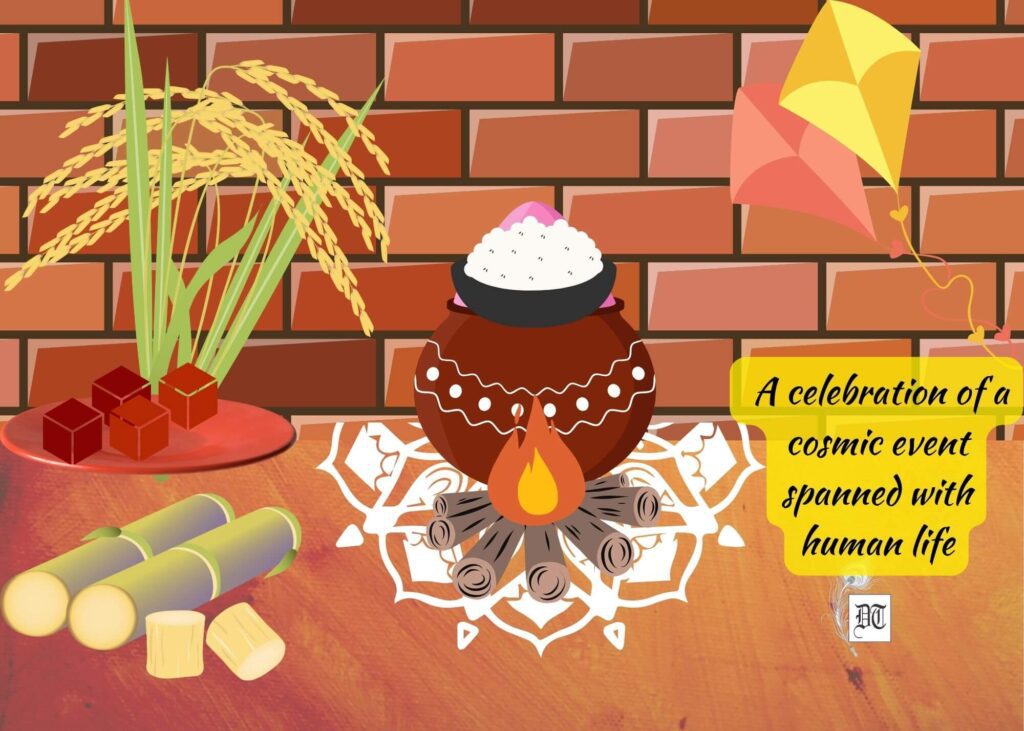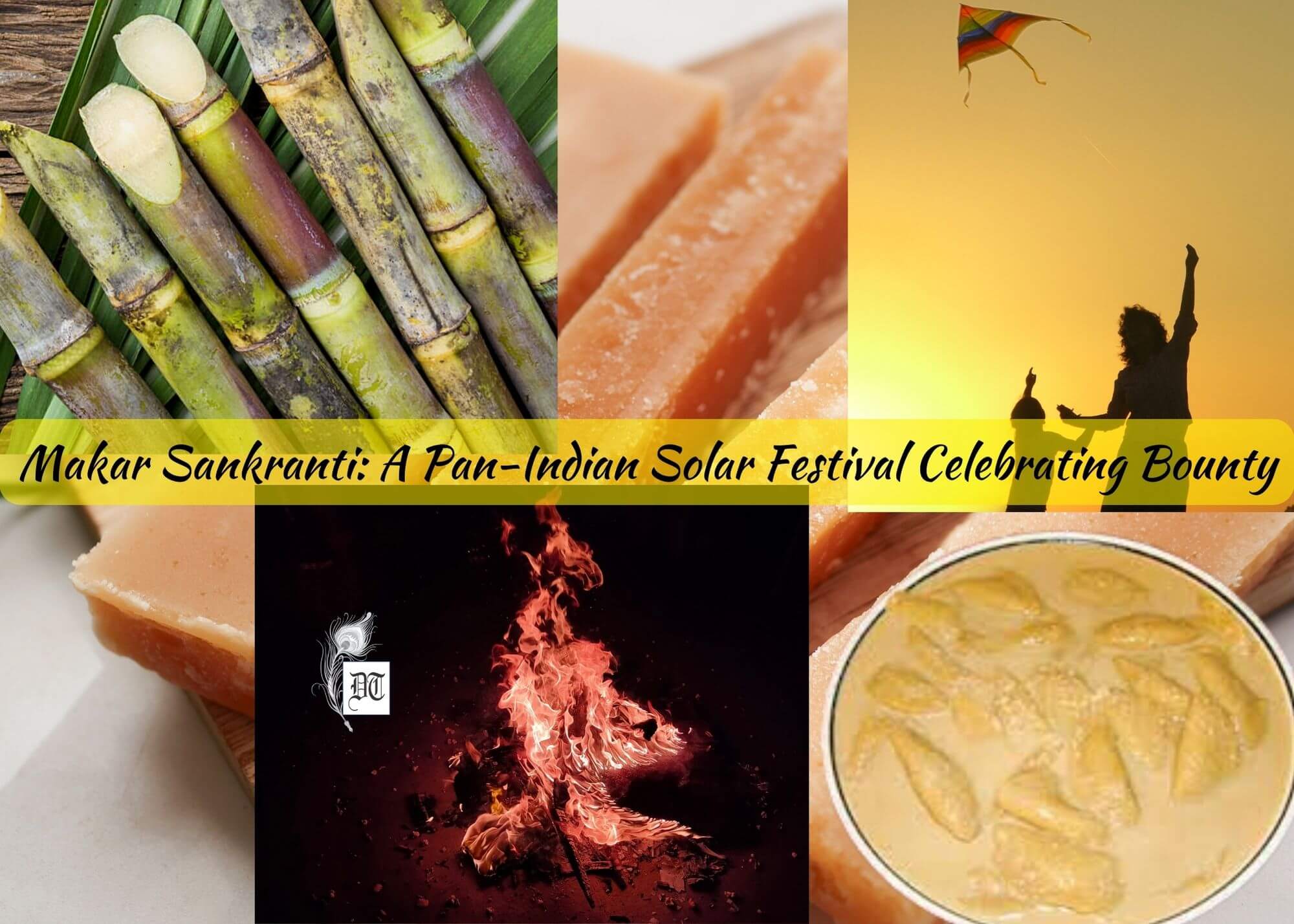Makar Sankranti is an important pan-Indian solar festival, known by different names. It is known as Pongal in Tamil Nadu, Pedda Panduga in Andhra Pradesh, Bihu in Assam, Magha Mela in parts of central and north India, as Makar Sankranti in the west, Lohri in North India and by other names. Makar Sankranti is observed with social festivities such as colourful decorations, social gatherings, fairs, kite flying, bonfires, and feasts, says Tapati, the January festivities, in the regular column. A Different Truths exclusive.
Cheers of ‘Pench, pench, pench’ ring in the air as a bunch of Sankranti revellers on a terrace crowd around the kite flyer who is in the thick of the action at the moment. The sun is sharp. I had to squint to fix my eyes on a bright red kite veering dangerously to a silver blue one. ‘Cut it, cut it’, someone screamed as the boy sent his kite swooping and in one swift move, swerved, tugged and pulled cutting the unknown kite to size. Scream of his friends pulled his manja and kite back and all broke into a little victory dance….The memories have still not faded, as I stood a spectator looking at the children gathered on our terrace.
Since last few days as my phone was flooded by digital messages “Happy Makar Sankranti”, they took me to travel through different allies of memories of the childhood days enjoying sweets and dishes made on this special occasion drizzled with a generous serving of a special gud (liquid jaggery from Dates plants). Last night all celebrated a bonfire with Lohri songs and sweets. All the main doors of the apartments in my neighbourhood today display of elaborate Rangoli made in the early morning. Everyone being dressed in new clothes, children playing around joyfully is adding to the festive flavour of Makar Sankranti; the festival is supposed to mark the first day when the sun is transiting into the Capricorn, also known as Makara.
Makara Sankranti also marks the end of the month when the winter solstice, which is also referred to as the darkest night of the year, happens. It also signals that longer days are here again. As per Hindu tradition, Makar Sankranti also marks the beginning of Uttarayana, a six-month auspicious period.
As per the traditional tales of Puranas, on this day the Sun God Surya meets his son Shani (Saturn – Lord of Capricor)…
As per the traditional tales of Puranas, on this day the Sun God Surya meets his son Shani (Saturn – Lord of Capricorn) as they do not share a very good relationship, so this is the day for a special father-son relationship. It is the son who has the responsibility to carry forward his father’s dream and the continuity of the family.
According to the narratives of Mahabharata, Bhishma had a boon for death from his father so he kept lying on the bed of arrows till Makara Sankranti day. Henceforth the common belief developed that the person, who dies during the period of Uttarayana becomes free from rebirth.
People wake up early in this month and make various designs with rice flour and colours before the entrance of their houses to welcome the gods in the morning.

Makara Sankranti is basically a celebration of a cosmic event spanned with human life. Sun enters from one zodiac to another. The sun is for knowledge, spiritual light, and wisdom.
Many people take a dip in places like Ganga Sagara, the point where the river Ganges meets the Bay of Bengal, and Prayag, and pray to the Sun God (Surya).Every twelve years, the Hindus observe Makar Sankranti with one of the world’s largest mass pilgrimage, with millions of people attending the event. At this event, they say a prayer to the sun and bathe at the Prayag confluence of the River Ganga and River Yamuna at the Kumbh Mela.
For most parts of India, this period is a part of early stages of the Rabi crop and agricultural cycle, where crops have been sown and the hard work in the fields is mostly over. The time thus signifies a period of socialising and families enjoying each other’s company, taking care of the cattle, and celebrating around bonfires.
Makar Sankranti is an important pan-Indian solar festival, known by different names.
Makar Sankranti is an important pan-Indian solar festival, known by different names. It is known as Pongal in Tamil Nadu, Pedda Panduga in Andhra Pradesh, Bihu in Assam, Magha Mela in parts of central and north India, as Makar Sankranti in the west, Lohri in North India and by other names. Makar Sankranti is observed with social festivities such as colourful decorations, social gatherings, fairs, kite flying, bonfires, and feasts.
Lohri marks the end of winter season and is a traditional welcome of longer days and sun’s journey to the northern hemisphere by Sikhs and Hindus in the northern regions of the Indian subcontinent. It is observed the night before Makar Sankranti, also known as Maghi. Lohri involves a Puja Parikrama around the bonfire and distribution of Prasad. This symbolizes a prayer to Agni, the spark of life, for abundant crops and prosperity. The first Lohri of a newborn child and a newlywed bride is considered very auspicious.
The second day is Makara Sankranti. People wear new clothes, pray to God
In Andhra Pradesh and Telangana, the day preceding Makara Sankranti is called Bhoghi when people discard old things and concentrate on new things causing change or transformation. At dawn, people light a bonfire with logs of wood, other solid fuels and wooden furniture that are no longer useful. The second day is Makara Sankranti. People wear new clothes, pray to God, and make offerings of traditional food to ancestors who have died. They also make beautiful and ornate drawings and patterns on the ground with chalk or flour. On the day after Makara Sankranti, the animal kingdom is remembered and, in particular, cows. Girls feed the animals, birds, and fish as a symbol of sharing. On the fourth day, farmers offer prayers to the elements like soil, rain, fire for helping the harvest and the village goddesses with their gifts call for celebrations with the union of families, friends, and relatives.
Kite flying is traditionally observed as a part of this festival. It began as being a sport for kings, but over time, as the sport became popular, it began to reach the masses.
However, these aspects of our cultural heritage seem to be fading away with the passage of time. Everything has become so artificial. Earlier ladies used to cook everything, now it’s all readymade. Even kite flying is not seen much. People go to kite festivals instead of flying with family and friends on the terrace. Gone are the days when we would spend time making our own kites and manja in a special way so that we could cut as many kites as possible. The excitement of cutting someone’s kite was immense. Til-gud laddoos were distributed. Food was given to the poor.
We have not forgotten the past and we are the combination of today and yesterday.
We have not forgotten the past and we are the combination of today and yesterday. We remember people used to visit homes and enjoy sesame laddoo, feni, and ghevar; haldi kumkum is becoming rare. Celebrating life this way was a real fun.
Keeping aside the tales and faiths behind this celebration of Makar Sankranti, my eyes got glued to focus on the kites flying over and soaring high. I lost count of them. Hundreds of kites are now floating over the bright blue sky; myriad colours of thin papers dazzling and dancing fiercely to cut the close ones, a great play of manipulating the string.
It has been so wonderful to be in touch with friends, from our years of innocence, years of trying to touch the sky and ride the winds. Gazing at the sky, my mind collects few colourful kites strewn around on the earth, it reminds how every festival reflects our life and the society we live in how the festivals reflect the efforts to bond people reminding their inherent values imbibed in the nature surrounding us as the celestial movements take place, the seasons change and calendars rotate, where people enjoy soaring high along the wind taking the kites higher and higher, fighting to cut the next one trying to rise and some are falling on the earth after losing the battle and the string to clinch on a mirror of our society?
Joyful cheers from nearby terraces bring my kite back to a new stride to fly along the colourful display in the sky, to join the celebrations.
Photos design Anumita Roy
#MakarShankranti #Lohri #Pongal #Bihu #HarvestCelebration #FestivalOfIndia #Joyful #Food #Kites #Puja #Prasad #NowAndThen #DifferentTruths







 By
By
 By
By

 By
By